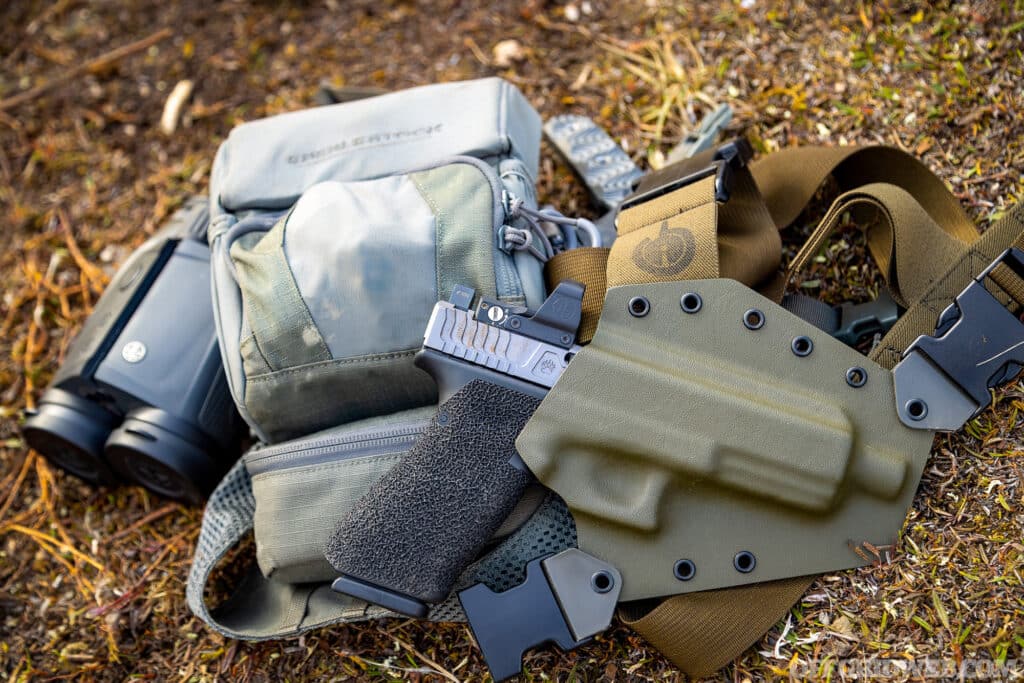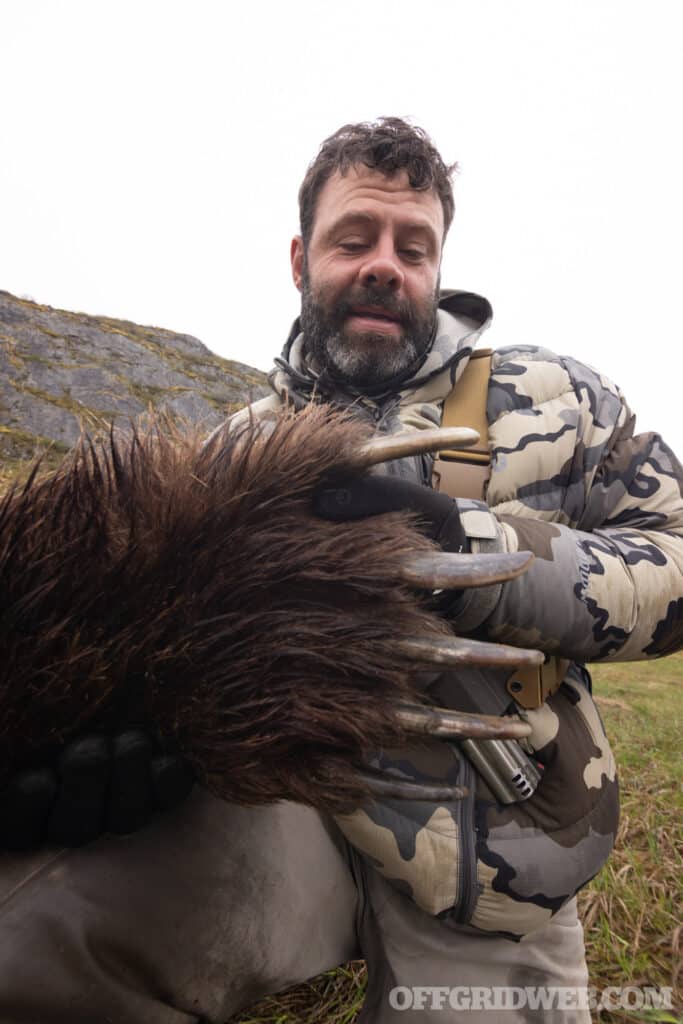RECOIL OFFGRID Preparation Outfitter Insights: The Best Bear Handgun
In This Article
When a bear is charging you, your life literally depends on the decisions you made up to that point. Do you have the right equipment for the job, and are you proficient with what you have chosen? Having encountered many bears while hunting for other game as an Alaska expedition guide, I know this scenario all too well. Fortunately, most encounters involve bears that don’t want to eat you, they just need an attitude adjustment. But for those creatures that mean lethal business, what is the best bear handgun caliber?
In the backcountry I have encountered various secondary weapons, from the 500 Smith & Wesson Magnum to the 460, .44 Magnum, the 10mm, and so on. One of the questions posed by many of my clients is, “What is the best handgun for bears?” My answer is simple: shootability.

Above: There are many options that could get the job done, but some are more ideal under stress than others.
The 500 and the 460 Smith & Wesson carry five rounds and weigh in at 3 1/2 pounds, making them a low-capacity and cumbersome option to carry on your chest or hip. The .44 Magnum, although easier to manage, suffers from the same constraint of round capacity, limiting the user to 5 to 6 rounds. Wearing a handgun that slows you down when hunting is a burden, and typically, when you get tired of carrying it, it’s placed in a pack and forgotten. What good is it then?

Recoil from these heavy firearms is manageable, but you usually won’t get fast follow-up shots after the gun rises off the target when you pull the trigger. Typically, most people are not sufficiently trained with a handgun and will rush, shoot too soon, and miss their first shot.

Above: .44 Mag has plenty of power, however, round capacity and follow-up shots could become a serious concern when charged by an apex predator.
If the bear then runs away, that is a win! However, if that bear stays committed to its charge, you may be in trouble. Revolvers will make follow-up shots difficult, as there is little time before the bear reaches you, given their ability to charge up to 35 mph.
Another problem with revolvers is their limited round capacity. Most of the time when I encounter a bear, I need to yell at it and shoot a few rounds, before it gets discouraged and scampers off. But there are always that 1% to 2% of bears that are a little more determined. They are not bluffing, and warning shots won’t do the trick. If you are limited with a 5 to 6-round capacity, you reduce the chances you can utilize your handgun noise to scare the bear away. After three warning shots and the bear, for whatever reason, decides to commit to the charge, you’re now down to two rounds. This is a big problem with revolvers as a bear gun. Ideally you want 12-15 rounds, giving you ample room for warning shots to scare the bear away before you must escalate to putting it down.
Several years ago, I was guiding a spring hunt on the Alaska Peninsula, an area where it is not uncommon to encounter bear as large as 10-feet. Spring is when bears wake up from their dens, and they are hungry because they haven’t eaten since the fall before. Typically, the ones that you have to worry about coming into camp are the younger juveniles. This spring was no exception.
We awoke to a ruckus outside of our tent early one morning on day three. Quickly getting up to investigate, I discovered a juvenile 8-foot male rummaging through our supplies. I was armed with a Glock 10mm carried in a GunFighters Inc. holster and a .375 Ruger. The hunter I was with was also out of his tent with a .416 Rigby. At only 20 yards away, the bear could have been on us in less than a second.

Above: Bears can smell food from as far as 20 miles away. This means, in some locations, no matter where you camp, a bear is going to know you're there.
This situation could have gone extremely bad quickly. However, based on the bear's body language, he was more interested in what he could steal from us, not in attacking us. With the client's .416 trained on the bear and my .375 loaded at my hip, I pulled my Glock 10mm, started shouting at the bear, and fired two warning shots.
From the bear's body language, it appeared that he was not sure what to do. He didn’t back away and he didn’t come forward, he just looked at us. A couple more warning shots and he still just looked at us like he was confused and didn’t want to leave. Finally, I fired 4 to 5 shots quickly in front of him, kicking dirt up just a few feet from his nose.
He still looked at us like he didn’t know what was going on, but this time he began to back up and walked off. We continued to shout at him as he slowly walked away. In total, it took about 8 to 10 rounds with my 10mm to convince the bear to leave. This scenario is one of the reasons why I do not believe the 500 or the 460 is the ideal bear gun for secondary protection.
In contrast to the traditional revolvers, modern semi-automatic pistols offer significant advantages in bear defense scenarios. My go-to is a modified Glock 20. Other great options are the Springfield XD-M ELITE and SIG P320-XTEN. These are great options since they can be loaded with 220-grain hard cast ammunition and have 15-16 rounds to handle bear encounters. It’s comforting to know that I can fire eight or more warning shots without running low on ammunition.
The 10mm also has significantly lower recoil than the other options discussed. If a bear decides to follow through with a charge, I’ll be able to quickly hit the bear with more rounds and still have great bullet penetration.

Above: A semi-auto 10mm is Caleb's go to bear gun.
For all these reasons, the 10mm stands out as an excellent bear defense caliber. It strikes a balance between power and manageability. This balance is crucial in high-stress situations where every second counts. Additionally, the 10mm's availability in various bullet weights and types provides flexibility for different scenarios and personal preferences.
We ran these guns side by side, and you can see for yourself how they stacked up here:
Above: If the above video isn't displayed, you can follow this link instead: https://youtu.be/zGtpI1oy3Ss?si=E_uM2LhWpFk5_agl
Striker fired handguns make it is easy to practice dry fire drills. Dry fire practice involves ensuring your gun is clear and safe, with no ammo, and manipulating the empty gun to get comfortable with handling it. Hunters, hikers, and everyone in between should get in as much dry fire practice as they can to become proficient with their weapons.
10mm striker-fired guns are great options for this, since revolvers can be more challenging to train with, and excessive dry-firing can potentially damage the firearm. Regular training is essential. Familiarity with your firearm's operation under stress can make the difference between a successful defense and a tragic outcome. Marksmanship when adrenaline is pumping is about muscle memory and the ability to operate your firearm instinctively.
In my experience, the best way to carry whatever a firearm in bear country is on your chest. The reason being is that it’s always accessible and it will not get hung up on brush like carrying on the hip will. I use the Kenai chest holster made by Gun Fighters Inc, a USA-made product by a veteran-owned and operated company.

Above: When moving through the brush, a chest rig will keep your bear gun accessible, and reduce the chances of it being snagged by vegetation or pack straps.
Chest holsters offer several advantages over other methods of carrying:
When you are selecting ammo for bear defense, you need to think the opposite of what you do for personal defense. For example, in town I want a hollow point that will expand quickly and stop inside of my intended target.
With a charging bear, you want very hard ammunition that has great penetration because you are trying to get through a lot of meat and thick bone. Consider using hard-cast lead, or deep-penetration, solid copper bullets. There are several good options on the market, such as Buffalo Bore for hard-cast, and 9g Defense for solid copper.

Above: Utilizing a chest rig will accommodate a multitude of bino carriers as well.
Even though it may be a little expensive, it is important to test your carry ammo and your gun before you go out and rely on it. Some ammo that works perfectly through one of my Glocks, malfunctions regularly in my other Glock. This is not a Glock problem. It is a fact that some ammo works well with certain guns and not with others.
It all goes back to prior proper planning prevents piss poor performance.
When considering a handgun for bear protection, the key factors are shootability, capacity, and comfort. The largest caliber isn’t always the best choice if it means compromising on your ability to quickly and accurately place multiple shots on target. The 10mm, with its balance of power, capacity, and manageability, offers an excellent option for those venturing into bear country. It provides the confidence that you have enough rounds to deter a bear without being weighed down or hindered by excessive recoil.
Remember, the best bear handgun is one that you are comfortable with and capable of using effectively under stress. Not only should it be powerful enough to stop a bear, but it should be manageable enough to allow for rapid and accurate shooting. Regular practice, proper training, and carrying your firearm in an accessible manner are all crucial components of effective bear defense.

Above: Do not underestimate the power a fully grown bear can wield. Carrying a proper bear gun in the wilderness is an important piece of protective gear.
Larger calibers like the 500 and 460 Smith & Wesson might seem like the ultimate bear defense guns, but their practicality in real-world scenarios is limited by their weight, recoil, and round capacity. Modern semi-automatic pistols, particularly in 10mm, offer a more balanced and effective solution for bear encounters. They provide the capacity for multiple warning shots, manageable recoil for quick follow-up shots, and the power to stop a charging bear. Equip yourself wisely, practice regularly, and respect the wilderness to ensure your safety and the safety of those around you.

Caleb Stillians, a seasoned professional in the realm of hunting, calls Alaska his playground. Specializing in guiding ventures across the state’s vast interior, peninsula, Kodiak, and coastal regions, Stillians leads hunting expeditions targeting grizzly bears, brown bears, mountain goats, Dall sheep, and moose. Embarking on his guiding journey at a young age, he finds his true calling in the wilderness, where he thrives on helping others realize their dream hunts, often spending months living in the backcountry. Beyond his guiding endeavors, Stillians is the visionary behind Outfitter Services, an online platform connecting adventurers with their next epic trip. He’s also the founder of Rise Up with Caleb Stillians, a production company crafting captivating films centered around the art of hunting.
Subscribe to Recoil Offgrid's free newsletter for regular updates on more content like this.
 STAY SAFE: Download a Free copy of the OFFGRID Outbreak Issue
STAY SAFE: Download a Free copy of the OFFGRID Outbreak Issue
No Comments